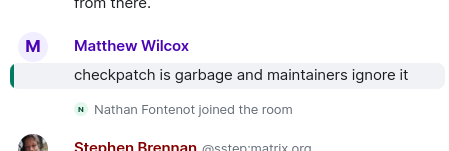Krzysztof Kozlowski
krzkThorsten Leemhuis (acct. 1/4)
kernellogger@fosstodon.orgBelow picture is from one of the public chats from the recent LPC. I've seen similar messages elsewhere from others.
I guess sooner or later we need a checkpatch bot that runs checkpatch on submitted patches and sends the results to the list, then you and others could just reply along the lines of "fix this up, but FWIW, ignoring the second warning is fine in this case"
kcxt (casey)
cas@social.treehouse.systems@kernellogger @krzk making b4 run checkpatch automatically would also be pretty nice
Krzysztof Kozlowski
krzkCheckpatch is garbage, but it is the only garbage we have, so till someone writes something better, please use it.
Krzysztof Kozlowski
krzkOne can do it easily on a Git forge.
Thorsten Leemhuis (acct. 1/4)
kernellogger@fosstodon.orgDon't worry, I use it. 😄 (But like everyone I occasionally forgot, which is another reason to make this run elsewhere).
"the only garbage we have": yup; the problem is that people can ignore it, otherwise maybe someone would have been bothered by it enough to improve it… 🥴
broonie
broonie@mastodon.social@krzk @kernellogger @cas OTOH for CI the forges are another set of tools to learn and adapt into your test lab (which may or may not be on the internet!) - there’s very little of the bits I find take any effort that they’re really dealing with. But that is with a bunch of physical systems in my testing flow, they seem better adapted to things you can do entirely in software.
Krzysztof Kozlowski
krzkI've been setting up different CI systems (Jenkins, Buildbot, Github and Gitlab) and the forges ones are really easy to start with. Complex things are complex everywhere, so I would not call it as a problem.
Plus you can opt-out and use your own CI, via some git-forge-hooks (if we talk about testing patches during review) or directly by git hooks / git fetch (if we talk about testing applied contributions).
broonie
broonie@mastodon.social@krzk @kernellogger @cas It’s more that the bits that the forges (or other CI tools) do aren’t super relevant for anything I’m doing - I would have to do the whole opt out via hooks thing which is a bunch of pure overhead and if you do external stuff the UX for anyone else tends to be poor for visibility reasons.
The off the shelf tooling does some things well, but if you’re having to do things that don’t fit naturally it can be a constant pain point.
